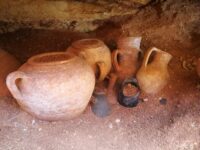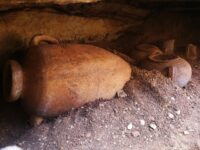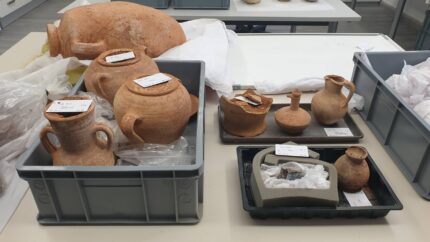 An intact Punic tomb has been unearthed in Żabbar, southeastern Malta. The 2,000-year-old tomb was discovered during expansion of the sewer network to the south of the island. Archaeologists opened the seal tomb to find a diverse group of vessels typical of the Punic period. They are excellent condition, almost all of them complete.
An intact Punic tomb has been unearthed in Żabbar, southeastern Malta. The 2,000-year-old tomb was discovered during expansion of the sewer network to the south of the island. Archaeologists opened the seal tomb to find a diverse group of vessels typical of the Punic period. They are excellent condition, almost all of them complete.
The contents of the tomb include one large amphora, two urns, an oil lamp and a glass ungentarium. Several of the larger urns contained cinerary remains, and the bones of an adult and a young child were found inside the tomb as well. This is evidence that the tomb was in use from the later Punic era through the early Roman era.
“The burial rite was altered through the Punic and Roman times. Sometimes the bodies were burnt, and other times they were buried intact in the grave. Cremation necessitated a variety of resources, including wood to burn the body and the presence of a person throughout the whole process of cremation which took several hours,” the [Water Services Corporation] said.
 Malta was colonized by Phoenicians in the 8th century and played an important role as a centralized stop along their Mediterranean trade routes. Another Phoenician colony, Carthage, took control of Malta in 480 B.C. and remained in control until they lost the island to Rome in the Second Punic in 218 B.C.
Malta was colonized by Phoenicians in the 8th century and played an important role as a centralized stop along their Mediterranean trade routes. Another Phoenician colony, Carthage, took control of Malta in 480 B.C. and remained in control until they lost the island to Rome in the Second Punic in 218 B.C.
Technically it was incorporated into Rome’s Sicily Province, but Malta was granted a certain autonomy under Roman rule and by the 1st century it had its own senate and popular assembly. The island appears to have maintained many of its ancient Punic cultural traditions, including funerary practices, well into the Roman imperial era. Even today Malta’s connection of Phoenicia is indelible; a 2005 genographic study found an unexpectedly strong prevalence of genetic markers shared between the people of coastal Lebanon and Malta. More than half the Y chromosome lineages in Malta originated with the Phoenicians.
The remains and pottery have been removed from the site and transported to a laboratory for cleaning, conservation and analysis.
